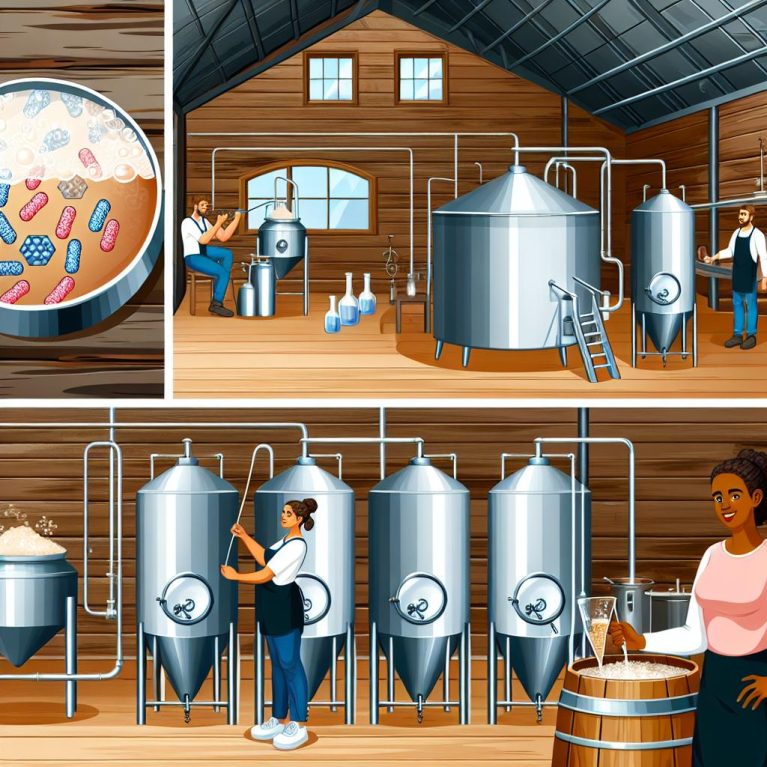Understanding the Complexity of Craft Beer Fermentation
Craft beer fermentation serves as the backbone of beer production, significantly influencing the beverage’s flavor, aroma, and overall quality. This intricate biochemical process is driven by microorganisms, primarily yeast, that play a pivotal role in converting sugars into alcohol and carbon dioxide. For brewers aiming to create unique and high-quality beers, a comprehensive understanding of this process is essential.
Core Role of Yeast in Fermentation
Yeast is an indispensable element in the beer fermentation process. As a single-celled fungus, yeast possesses the distinctive ability to ferment sugars, leading to the production of alcohol and various by-products. In the realm of beer production, two primary types of yeast are utilized: Saccharomyces cerevisiae and Saccharomyces pastorianus.
Saccharomyces cerevisiae, also referred to as ale yeast, operates optimally in warmer temperature conditions, typically ranging from 60-75°F. This strain is renowned for imparting the fruity and complex flavor profiles often associated with ales. In contrast, Saccharomyces pastorianus, commonly known as lager yeast, thrives at cooler temperatures, generally between 45-55°F, contributing to the clean and crisp taste characteristic of lagers.
Sequential Stages of Fermentation
The process of fermentation in craft beer occurs in various stages, each contributing to the development of the final product:
1. Lag Phase: During this initial period, yeast acclimates to its environment, absorbs essential nutrients, and prepares for active fermentation. This phase tends to last only a few hours, yet it is critical for setting the stage for subsequent activity.
2. Active Fermentation: Here, yeast begins metabolizing sugars, predominantly glucose and maltose, leading to the production of alcohol and carbon dioxide. This phase, typically lasting several days, is marked by vigorous bubbling as the yeast actively ferments.
3. Maturation: Once the majority of sugars have been fermented, yeast cells focus on consuming any remaining by-products such as diacetyl. This stage facilitates the refinement of beer flavor, varying in duration from a few days to several weeks, depending on the desired flavor profile.
4. Conditioning: The final stage involves the stabilization and clarification of beer, enhancing its overall taste and aroma. Occurring often at colder temperatures, conditioning serves to improve the beer’s stability and extend its shelf life.
Influential Factors in Fermentation
Multiple factors play a role in shaping the fermentation process, ultimately impacting the flavor and quality of craft beer. These include temperature, yeast strain selection, and the composition of the wort.
Temperature: Maintaining an appropriate fermentation temperature is essential as it significantly influences yeast activity. Excessively high temperatures can result in the development of off-flavors, while excessively low temperatures can slow down the fermentation.
Yeast Strain: The choice of yeast strain largely determines the flavor profile, as different strains produce distinctive flavors. Brewers carefully select yeast strains to align with the desired beer characteristics.
Wort Composition: Known as wort, the fermentation mixture comprises sugars, proteins, and various nutrients. The composition of wort has a direct impact on yeast activity, subsequently influencing the beer’s taste and aroma.
Technological Innovations in Fermentation
The craft beer industry has witnessed numerous technological advancements that have equipped brewers with sophisticated tools to monitor and control the fermentation process more effectively. Modern instruments, such as fermentation tanks with precision temperature control, gas chromatographs for analyzing volatile compounds, and spectrophotometers for measuring optical density, have significantly improved the consistency and quality of craft beer.
For those seeking more extensive resources on fermentation in craft brewing, a wealth of articles and guides are available on platforms such as Brewers Association and CraftBeer.com.
In conclusion, a thorough understanding of craft beer fermentation enables brewers to create beverages that are both innovative and of high quality. Mastering this intricate process allows artisans in the field to produce craft beers that appeal not only to novices but also to seasoned connoisseurs, pushing the boundaries of traditional brewing with creativity and precision.

